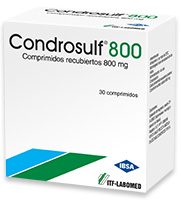
Condrosulf 800 Otzivi
Efficacy Study of Condrosulf in the Treatment of Symptomatic OA of the Hand.  The goal of the present study is to investigate the effectiveness of Condrosulf® 800.
The goal of the present study is to investigate the effectiveness of Condrosulf® 800.
The goal of the present study is to investigate the effectiveness of Condrosulf® 800 mg tablets vs. Placebo once a day for 6 months in the symptomatic treatment of finger joint osteoarthritis in 160 randomised patients. Primary endpoints: Primary endpoints of the study are the evaluation of global spontaneous pain (Huskisson's Visual Analogue Scale: VAS) and the score of Dreiser's algo-functional index (FIHOA) during the treatment with the tested product, Condrosulf®, versus placebo. Secondary endpoints are: Efficacy evaluation: Global impression of efficacy expressed by the patient and the physician (VAS), Grip strength (measured manometrically); Morning stiffness duration; Consumption of Paracetamol; Tolerability (4-point verbal scale); Adverse Events occurring during the treatment period; Other parameters:Treatment compliance; Biological markers of arthritis.
Inclusion Criteria: - Patients of either sex - Aged 40 and over - Outpatients - Patients fulfilling the ACR criteria for the reporting of hand OA - Patients showing X-ray features of hand OA on at least two joints (2 IP and/or 1 IP and 1 TMC) of the dominant hand on standard plain radiographs ( or = 40 mm at inclusion time). - Showing a FIHOA score > or = 6. - Having had at least two painful flares in a finger joint during the previous 12 month.
- Patients who have signed the written informed consent for their participation in the study - Patients able to understand and follow the protocol. - Patients with a satisfying health and nutritional status. - Female subjects of childbearing potential using, within three months prior to the inclusion in the study, a reliable form of contraception during the course of the study (oral contraceptive pill, intrauterine device or condoms) or female of non childbearing potential (hysterectomy, bilateral ovariectomy or tubal section/ligation). - Female subjects of childbearing potential with a negative urinary pregnancy test before the inclusion in the study. In Phase 1 (Phase I) clinical trials, researchers test a new drug or treatment in a small group of people (20-80) for the first time to evaluate its safety, determine a safe dosage range, and identify side effects. In Phase 2 (Phase II) clinical trials, the study drug or treatment is given to a larger group of people (100-300) to see if it is effective and to further evaluate its safety.
In Phase 3 (Phase III) clinical trials, the study drug or treatment is given to large groups of people (1,000-3,000) to confirm its effectiveness, monitor side effects, compare it to commonly used treatments, and collect information that will allow the drug or treatment to be used safely. In Phase 4 (Phase IV) clinical trials, post marketing studies delineate additional information including the drug's risks, benefits, and optimal use. These phases are defined by the Food and Drug Administration in the Code of Federal Regulations.